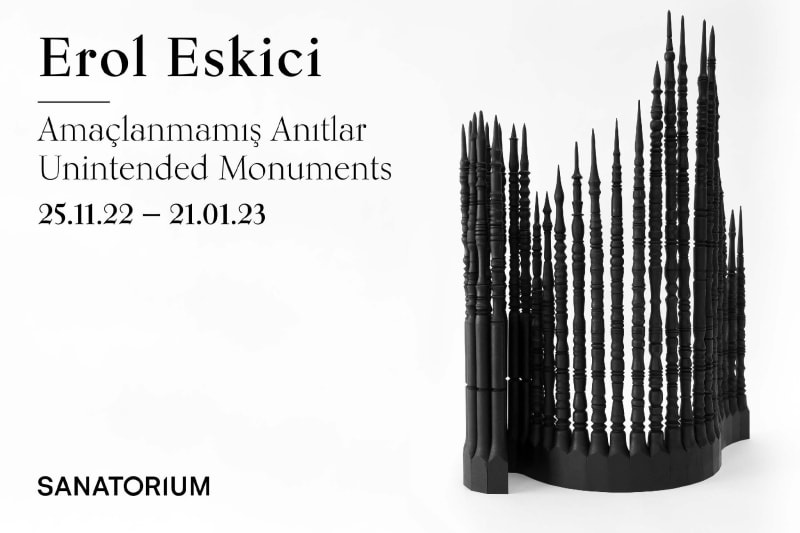Unintended Monuments
Erol Eskici
The word Monument originates from the Latin word monumentum which has meanings regarding memory and reminiscence, such as reminder, memory, trace, keepsake. Monuments are structures that are built with the aim of keeping the memory of mankind’s special deeds, skills or important events alive in the minds of future generations. However, not all monuments are built, and indeed, a monument does not have to be a structure at all. While some monuments are works of art, others might be textual works. Some of the living beings today have a monument status. An analog or digital record (for example, M. L. King’s “I Have A Dream”) might have a monument status in the future as well. The German word Denkmal, which means monument/memorial, originates from the verb “to think” in German. But what if one should make a definition of monument beyond didactic definitions? Eileen Legaspi-Ramirez defines it as follows: “A monument is an instrument for conveying idealized notions or naturalized values held up as desirable and immutable. As an embodied means to constitute history or what are projected to be life-story anecdotes, monuments are crafted to address the inevitable loss of meaning and the failing of memory, as well as to act as a buffer for fabricated or fashioned narratives. A monument is a materialized, deliberate marking-off of a juncture in time combined with a prescribed aspirational reading.” [1]
“Unintended Monuments” is one of the important pillars of the conceptual classification mechanics that the Austrian art historian Aloïs Riegl has defined and established in his article “The Modern Cult of Monuments: Its Character and Its Origin”. According to this, “Unintended Monuments” are works which have not been consciously designed and created with the aim of becoming a monument to refer to a certain person or event or to commemorate the person or the event in question, but which have gained value as monuments due to the fact that they carry the traces of the past or are considered to indicate to a certain moment in history. [2] Making itself apparent in Eskici’s works entitled Nostomania - also the title of his solo exhibition in 2015 at SANATORIUM - the “antiquity value” is included within the category of remembrance/commemoration in Riegl’s classification of monument values. It indicates to the value given to the tangible traces of natural aging, decay, deformation and physical loss that are generally seen in beings and artifacts. In his article entitled “Ruins”, Georg Simmel wrote that what differentiates ruins from other artworks is that in ruins, subjugated natural material gets rid of its yoke, becomes free again under the laws of natural forces and gains new meanings at the same time. Riegl’s concept of antiquity value seems to be closer to the environment indicated by Simmel rather than being a kind of ruinophilia. Svetlana Boym writes in her article entitled ‘’Ruinophilia: Appreciation of Ruins” as follows: “There is one important difference between ruinophilia and nostalgia: ruinophilia is less afflicted by the personal story; it is not a longing for home or for identity but more of a material and visceral experience of the irreversibility of time that comes together with care for the world. Ruinophilia can be antinarcissistic but not less melancholic, in spite of its perspectivism and inspirations.”
Nature monument (Naturdenkmal) in German consists of the words Natur, which means “nature” and Denkmal, which means “monument, memorial”. Nature monuments are considered as beings or monuments which have been created without any human contribution as a result of natural and geological events with all its beauties and oddities, and which consist of all plants, animals and inorganic materials in their environments and thus deserve to be protected. Dealing with the concepts and facts regarding the science of geology - the focus of his previous exhibition - with these arguments by Riegel, the artist has learned the lathe technique in order to produce his works which are positioned at a parallel point between organic and inorganic nature monuments and “Unintended Monuments”. Since the lathe technique, by nature, depends on anisotropy, the exhibition mostly includes wooden material. Anisotropy indicates the direction-dependent properties of a material or is defined as the direction-dependency of the properties of a material. At the same time, wood is also important since it is the material which the decompositional and destructive forces of nature feed into the most. The lathe technique indicates to centrifugal forces, to the act of cutting and scraping.
Just like the dynamics of natural construction and destruction, Eskici, on one hand, reduces the singular material that his works are composed of, while he, on the other hand, synchronizes and stratifies these singularities by adding them to each other. As Simmel puts it: “Even the charm of alpine forms which are, after all, for the most part, clumsy, accidental, artistically insipid - rests on the felt counterplay of two cosmic tendencies: volcanic eruptions or gradual stratification have built the mountain upward; rain and snow, weathering and landslides, chemical dissolution, and the effect of gradually intruding vegetation have sawed apart and hollowed out the upper ledge, have cast downward parts of what had been raised up, thus giving the contour its form. In this form, we feel the vitality of those opposing tendencies, and - instinctively sensing these antitheses in ourselves - we notice, beyond everything merely formal and aesthetic, the significance of the configuration in whose serene unity they have their synthesis.”
[1] Eileen Legaspi-Ramirez, The Monument, Atlas of Transformation
[2]Aloïs Riegl, Modern Anıt Kültü, çev. Erdem Ceylan, arketon, 2022
[3] Georg Simmel, Ruins, The Hudson Review, 1958

